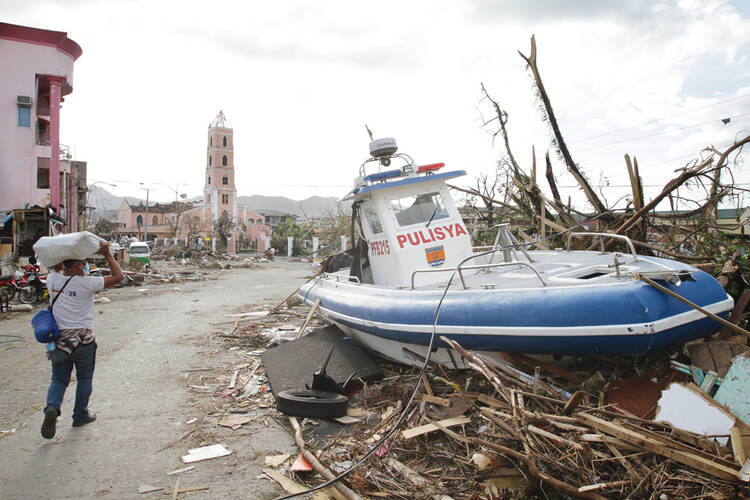I. J. Chan-Gonzaga, S.J., grew up in Tacloban City in the Vasayas Islands of central Philippines. Now he is struggling to adjust the image of the community he knew with the scenes of destruction, death and human suffering he encountered when he returned to Tacloban on Nov. 11. Three days after the storm, amid the debris left behind by hundreds of modest wooden homes washed away by supertyphoon Haiyan, “there were just bodies lying in the street,” said Father Chan-Gonzaga.
“This is no longer the Tacloban that we loved. Everything is gone. [My] high school is gone; the church where I did my first thanksgiving Mass three years ago when I made my ordination…the only thing remaining there is the altar.”
But worse, he said, was his final image of Tacloban, pushing through a crowd of people desperate to leave the ruined city and rushing to a waiting military transport. Father Chan-Gonzaga said he was “still trying to process” the sight of the friends and families he left behind on the tarmac at what had been Tacloban airport.
Father Chan-Gonzaga ran into a childhood friend and her family among hundreds of others trying to reach the city’s airport, walking away from communities that had been swept away in the 15-foot storm surge. What was she doing? he asked. Where was she trying to go? “Anywhere but here,” the woman told him.
With good reason. Relief supplies were piling up at the Tacloban airport, but little was making it into what was left of the town where residents had been engaged in a daily struggle to survive since the typhoon raked the city on Nov. 8. A week after the storm, children were becoming ill from drinking dirty water and looting had broken out as survivors searched for food. The city’s municipal authorities urged residents who could manage it to leave Tacloban until order could be restored.
Father Chan-Gonzaga had gone to Tacloban to find his grandmother. The 99-year-old had survived the storm clinging to the back of a neighbor as the waters rose around them, finding safety finally on the second floor of a neighbor’s home. Her harrowing story was just one of thousands being told among survivors in a devastated community where finding a refuge on an upper floor of a sturdy building often made the difference between life and death. On Nov. 15 the death toll was still rising, but the official figure was nearing 4,000. Thousands had been injured and two million people had been displaced by the storm. Unattended children were observed wandering Tacloban City. Some are concerned they might become victims of child predators or human traffickers. Patience had run out among average Filipinos frustrated by the government’s response to the crisis.
Catholic Relief Services reported that its teams, along with an army of other disaster response agencies, were managing to reach survivors with food, water and temporary shelters. A U.S. navy strike force arrived on Nov. 14 to assist overwhelmed Philippine government agencies.
In Baltimore on Nov. 11 what might have been a more or less perfunctory status report on Catholic Relief Services from Bishop Gerald Kicanas of Tucson, chairman of the C.R.S. board, and Carolyn Woo, president of C.R.S., took a dramatic turn as the scope of the catastrophe in the Philippines became clear. C.R.S. made an initial commitment of $20 million in emergency aid for survivors.
“Our goal is to serve 100,000 families, about a half million people,” Carolyn Woo told the bishops at the U.S.C.C.B. fall general assembly on Nov. 11. The bishops scheduled a special collection to support relief efforts on the weekends of Nov. 16-17 or Nov. 30-Dec. 1. For more information, visit www.crs.org, www.caritas.org or www.phjesuits.org/pjf/share.php.
I.J. Chan-Gonzaga, S.J. talks about the devastation wrought by Typhoon Hiayan on our podcast.








